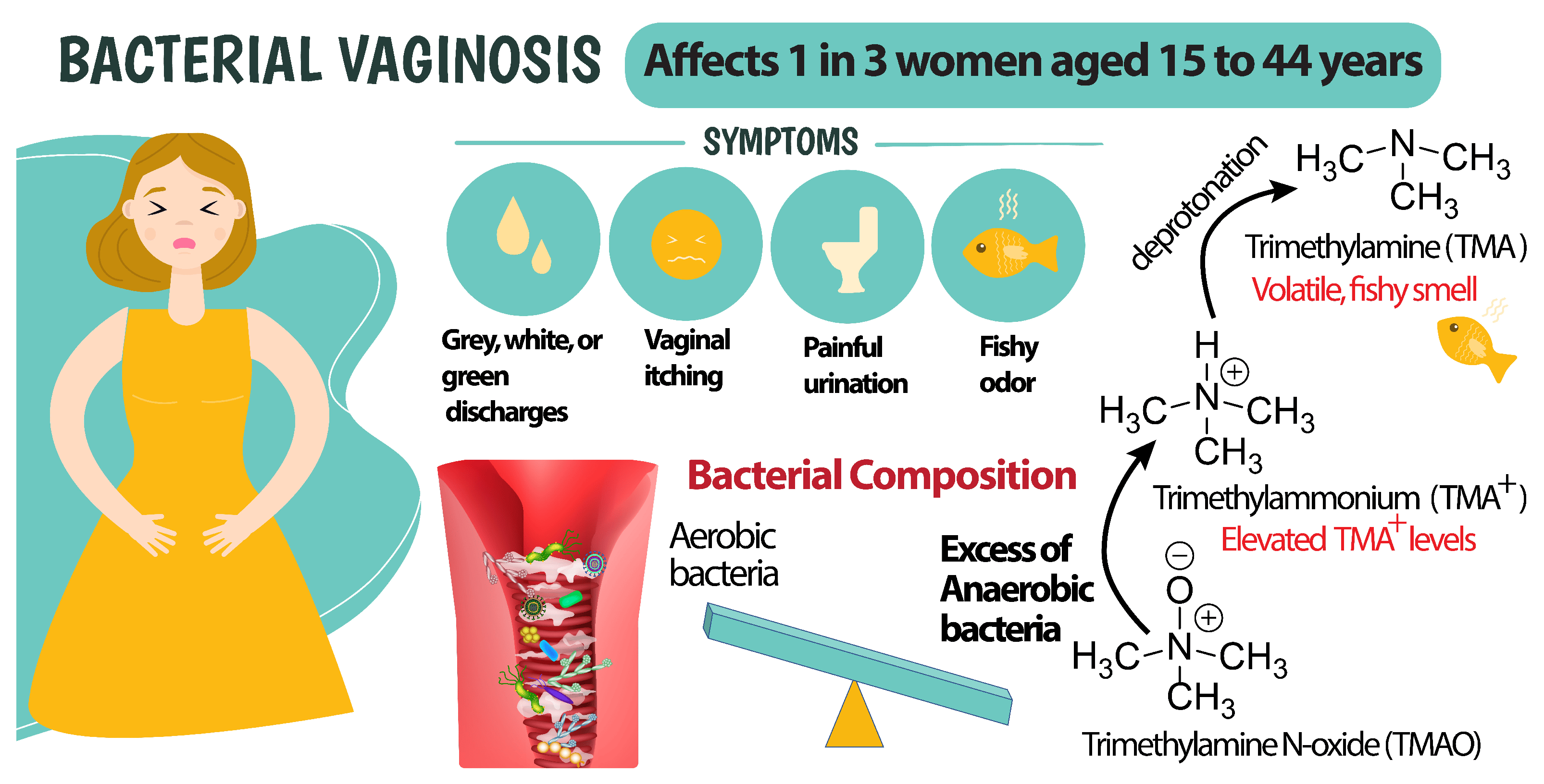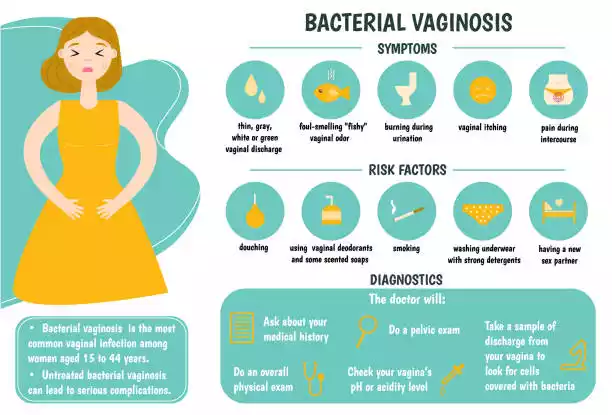Bacterial vaginosis is a common vaginal infection that affects many women. Understanding its causes, symptoms, diagnosis, complications, and preventive measures is crucial for maintaining vaginal health. The exact cause of bacterial vaginosis is not fully understood, but certain factors such as pH imbalance, sexual activity, douching, smoking, and hormonal changes can contribute to its development.
It often presents with symptoms like abnormal discharge, vaginal itching, a burning sensation during urination, and a distinct fishy odor. Timely diagnosis through pelvic examination and laboratory testing is essential to confirm the presence of BV. If left untreated, bacterial vaginosis can lead to complications such as an increased risk of sexually transmitted infections, pelvic inflammatory disease, and pregnancy-related complications.
Fortunately, there are preventive measures that can help minimize the risk, including practicing safe sex, limiting the number of sexual partners, avoiding douching, and maintaining good hygiene. In this article, By understanding the causes, symptoms, diagnosis, complications, and preventive measures associated with bacterial vaginosis, women can take proactive steps toward maintaining optimal vaginal health and well-being.
Bacterial Vaginosis: End In 03 Days or Less
Bacterial vaginosis (BV) is a common vaginal infection that affects many women worldwide. Bacterial vaginosis is a condition that occurs when the balance of bacteria in the vagina is disrupted, leading to an overgrowth of certain bacteria. This imbalance can cause various uncomfortable symptoms and, if left untreated, may lead to complications. Fortunately, there are several treatment options available to manage and alleviate the symptoms of bacterial vaginosis effectively.
Here, we will delve into the details of bacterial vaginosis, discussing its causes, symptoms, and various treatment options available to address this condition effectively.
Understanding Bacterial Vaginosis
Bacterial vaginosis is the most common vaginal infection among women of reproductive age. It is characterized by a change in the bacterial composition of the vagina, with a decrease in the presence of beneficial lactobacilli and an increase in harmful bacteria such as Gardnerella vaginalis. This disruption in the vaginal microbiome can result in an overgrowth of bad bacteria, leading to the development of BV.
Causes of Bacterial Vaginosis
The exact cause of bacterial vaginosis is not fully understood, but certain factors have been identified as potential triggers. These include:
I. Imbalance of vaginal pH:
The vagina maintains a delicate balance of acidity, primarily regulated by beneficial bacteria called lactobacilli. These lactobacilli produce lactic acid, which helps keep the vaginal pH slightly acidic (around 3.8 to 4.5). This acidic environment inhibits the growth of harmful bacteria. However, any disruption in the vaginal pH levels can contribute to the development of bacterial vaginosis (BV). When the pH becomes less acidic, it creates an environment that favors the overgrowth of other bacteria, such as Gardnerella vaginalis, leading to BV.
II. Sexual activity:
Engaging in sexual intercourse, especially with multiple partners or a new partner, can increase the risk of developing bacterial vaginosis. The exact reason is not fully understood, but it is believed that the exchange of bacteria during sexual activity may contribute to the disruption of the vaginal microbiome. This can lead to an imbalance in the bacterial composition and increase the likelihood of BV.
III. Douching:
Regular douching, which involves rinsing the vagina with water or other cleansing agents, disrupts the natural balance of bacteria in the vagina. Douching can wash away the beneficial lactobacilli that help maintain a healthy vaginal environment. This disruption allows harmful bacteria to overgrow, leading to bacterial vaginosis. It is important to note that the vagina is self-cleaning and does not require douching for hygiene purposes.
IV. Smoking:
Smoking has been linked to an increased risk of bacterial vaginosis. Although the exact mechanism is not fully understood, it is believed that smoking may alter the vaginal pH and affect the immune system’s response. Smoking can lead to a decrease in beneficial lactobacilli and an increase in harmful bacteria, creating an environment conducive to the development of BV.
V. Hormonal changes:
Fluctuations in hormone levels can disrupt the delicate balance of the vaginal microbiome and trigger bacterial vaginosis. Hormonal changes commonly occur during menstruation and menopause. The decrease in estrogen levels during menopause can lead to changes in the vaginal environment, making it more susceptible to bacterial overgrowth. Similarly, hormonal fluctuations during the menstrual cycle can temporarily alter the vaginal pH and bacterial composition, potentially increasing the risk of BV.
It is important to note that while these factors are associated with an increased risk of bacterial vaginosis, they do not guarantee its development. The exact cause of BV is still not fully understood, and it may involve a combination of various factors. Additionally, some women may develop BV without any identifiable risk factors, emphasizing the complex nature of the condition.
Symptoms of Bacterial Vaginosis
Bacterial vaginosis may present with various signs and symptoms, although some women may remain asymptomatic. Common symptoms of BV include:
I. Vaginal discharge:
Bacterial vaginosis often presents with a characteristic vaginal discharge. The discharge is typically thin, grayish-white, and may have a homogenous or frothy appearance. One of the hallmark features of BV is its distinct odor, often described as fishy. This odor becomes more pronounced after sexual intercourse or during menstruation. It is important to note that not all women with bacterial vaginosis experience noticeable vaginal discharge.
II. Vaginal itching and irritation:
Some women with bacterial vaginosis may experience vaginal itching and irritation. This itching can be mild to moderate and is typically localized to the vaginal area. The irritation may cause discomfort and a general feeling of unease.
III. Burning sensation during urination:
Bacterial vaginosis can cause a burning or stinging sensation during urination. This symptom is similar to the discomfort experienced during a urinary tract infection (UTI). It is important to differentiate between BV and a UTI, as they require different treatment approaches.
IV. Vaginal odor:
An unpleasant odor is a hallmark symptom of bacterial vaginosis. The odor is often described as fishy and is typically more noticeable after sexual intercourse or during menstruation. The odor results from the overgrowth of certain bacteria, such as Gardnerella vaginalis, in the vaginal ecosystem. It is important to note that not all women with BV experience a strong odor, and some may be asymptomatic despite the presence of the infection.
It is essential to remember that the symptoms of bacterial vaginosis can vary from person to person. Some women may experience all of the above symptoms, while others may only have a mild odor or be completely asymptomatic. If you suspect you have bacterial vaginosis or are experiencing any unusual vaginal symptoms, it is advisable to consult a healthcare professional for an accurate diagnosis and appropriate treatment.
Blood Sugar | Diabetes: Understanding, Treatment, and Prevention In 2023
Diagnosis of Bacterial Vaginosis
To diagnose bacterial vaginosis, a healthcare provider will perform a pelvic examination and evaluate the symptoms. Additionally, they may collect a sample of vaginal discharge for further analysis. The sample can be examined under a microscope or sent to a laboratory for testing to confirm the presence of BV.
To diagnose bacterial vaginosis, a healthcare provider will typically perform the following steps:
I. Pelvic examination:
During a pelvic examination, the healthcare provider will visually inspect the external genitalia and then insert a speculum into the vagina to examine the vaginal walls and cervix. This allows them to observe any visible signs of infection or abnormal discharge.
II. Evaluation of symptoms:
The healthcare provider will ask about the symptoms you are experiencing, such as vaginal discharge, odor, itching, or discomfort. They will inquire about the duration and nature of the symptoms to gain a better understanding of your condition.
III. Collection of vaginal discharge samples:
To confirm the diagnosis of bacterial vaginosis, the healthcare provider may collect a sample of your vaginal discharge for further analysis. They may use a cotton swab or a small spatula to gently obtain the sample from the vaginal walls or cervix. The sample collection procedure is usually painless and quick.
IV. Laboratory testing:
The collected vaginal discharge sample may be examined under a microscope or sent to a laboratory for testing. There are various laboratory methods available to analyze the sample, such as the Gram stain test or the whiff test (amine test).
V. Gram stain test:
This test involves staining the vaginal discharge sample with a dye and examining it under a microscope. It helps identify the presence of certain bacteria associated with bacterial vaginosis, such as the characteristic “clue cells.” Clue cells are vaginal cells covered with bacteria, and their presence is a strong indicator of BV.
VI. Whiff test (amine test):
In this test, a small amount of potassium hydroxide (KOH) solution is added to the vaginal discharge sample. The KOH helps release certain volatile compounds that produce an odor when combined with the discharge. A fishy odor confirms the presence of BV.
VII. Additional tests:
In some cases, the healthcare provider may order additional tests, such as DNA-based tests or culture tests, to further identify the specific bacteria causing the infection or to rule out other possible infections.
It is important to seek medical attention for a proper diagnosis of bacterial vaginosis. Self-diagnosis based solely on symptoms is not recommended, as other vaginal infections or conditions may present with similar symptoms. With an accurate diagnosis, the healthcare provider can recommend appropriate treatment options tailored to your specific needs.
Complications Associated with Bacterial Vaginosis
If left untreated, bacterial vaginosis can lead to various complications, including:
I. Increased risk of sexually transmitted infections (STIs):
Women with bacterial vaginosis (BV) have an increased risk of acquiring sexually transmitted infections (STIs) such as chlamydia, gonorrhea, and HIV. The exact reason for this association is not fully understood, but BV may alter the vaginal environment, making it more susceptible to the entry and establishment of other infections. Additionally, the presence of BV can cause inflammation and compromise the natural defense mechanisms of the vagina, increasing the vulnerability to STIs.
II. Pelvic inflammatory disease (PID):
Bacterial vaginosis can increase the chances of developing pelvic inflammatory disease (PID). PID is a serious infection that affects the female reproductive organs, including the uterus, fallopian tubes, and ovaries. If left untreated, PID can lead to chronic pelvic pain, infertility, and potentially life-threatening complications such as abscess formation or ectopic pregnancy. The presence of BV creates an environment conducive to the ascent of bacteria from the vagina into the upper reproductive tract, increasing the risk of PID.
III. Pregnancy complications:
Pregnant women with bacterial vaginosis are at an increased risk of experiencing various complications during pregnancy. These complications include:
A. Preterm birth:
BV has been associated with an increased risk of preterm birth, which is defined as giving birth before 37 weeks of gestation. Preterm birth can lead to potential health issues for the baby, including respiratory problems, developmental delays, and other complications.
B. Low birth weight:
Bacterial vaginosis during pregnancy has also been linked to a higher risk of delivering a baby with a low birth weight (less than 2,500 grams or 5.5 pounds). Low birth weight babies may face difficulties in growth and development and have an increased risk of certain health problems.
C. Postpartum infections:
Women with BV are at an increased risk of developing postpartum infections following delivery. These infections can occur in the uterus (endometritis) or the surgical incision site (if a cesarean section was performed), leading to complications and prolonged recovery.
It is important to seek prompt medical attention for the diagnosis and treatment of bacterial vaginosis, especially in pregnant women or those at risk of complications. Early intervention can help reduce the risk of developing associated complications and ensure the best possible outcomes for both the mother and the baby.
Treatment Options for Bacterial Vaginosis
Thankfully, bacterial vaginosis is a treatable condition. The following treatment options are available:
I. Antibiotics
Antibiotics are commonly prescribed to eliminate the harmful bacteria causing BV. Metronidazole and clindamycin are two of the most commonly used antibiotics for treating bacterial vaginosis. These medications can be taken orally or applied topically in the form of gels or creams. It is crucial to complete the full course of antibiotics as prescribed by the healthcare provider, even if the symptoms improve before completing the treatment.
II. Probiotics
Probiotics, particularly those containing Lactobacillus species, can help restore the natural balance of bacteria in the vagina. These can be taken orally or used as vaginal suppositories. Probiotics promote the growth of beneficial bacteria, thus inhibiting the overgrowth of harmful bacteria responsible for BV.
III. Home Remedies
Several home remedies may provide relief from the symptoms of bacterial vaginosis. These include:
A. Maintaining good hygiene:
Practicing good hygiene is essential for preventing the recurrence of bacterial vaginosis. It is important to keep the vaginal area clean and dry. However, excessive cleaning or harsh scrubbing should be avoided as it can disrupt the natural balance of the vagina. Gently washing the external genital area with warm water and a mild, unscented soap is sufficient.
B. Avoiding douching:
Douching is the practice of rinsing or cleaning the vagina with water or other solutions. It is important to avoid douching as it disrupts the natural balance of the vagina. The vagina is a self-cleaning organ, and douching can wash away the beneficial lactobacilli that help maintain a healthy environment. This can lead to an overgrowth of harmful bacteria, exacerbating the symptoms of bacterial vaginosis.
C. Using mild, unscented soaps:
Harsh soaps and scented products can irritate the delicate tissues of the vagina and disturb its natural pH balance. It is recommended to use mild, unscented soaps or cleansers specifically formulated for the genital area. These gentle products help maintain the natural vaginal environment and minimize the risk of irritation or further bacterial imbalances.
D. Wearing breathable underwear:
The type of underwear you choose can impact the vaginal environment. Opting for breathable underwear made of cotton fabric is advisable. Cotton allows proper airflow and absorbs moisture, helping to keep the vaginal area dry. Moisture can create a favorable environment for bacterial growth, so wearing breathable underwear reduces the chances of bacterial overgrowth and helps maintain a healthier vaginal ecosystem.
It’s important to note that while these home remedies may provide some relief from the symptoms of bacterial vaginosis, they may not be sufficient to eliminate the infection. If you suspect you have bacterial vaginosis or experience persistent or recurrent symptoms, it is recommended to consult a healthcare professional for an accurate diagnosis and appropriate treatment.
Preventive Measures for Bacterial Vaginosis
To minimize the risk of developing bacterial vaginosis or prevent its recurrence, consider the following preventive measures:
I. Practice safe sex:
Consistently using condoms during sexual activity can help minimize the risk of acquiring bacterial vaginosis. Condoms act as a barrier, reducing exposure to potentially harmful bacteria and reducing the chances of infection. However, it’s important to note that condoms may not provide complete protection, as bacterial vaginosis can also develop from factors other than sexual activity.
II. Limit the number of sexual partners:
Engaging in sexual activity with multiple partners increases the risk of bacterial vaginosis. Having fewer sexual partners reduces the likelihood of exposure to different types of bacteria and lowers the risk of developing an imbalance in the vaginal ecosystem. It’s important to prioritize safe and responsible sexual practices to help prevent bacterial vaginosis.
III. Avoid douching:
Douching refers to the practice of rinsing or cleaning the vagina with water or other solutions. Douching disrupts the natural balance of the vagina by washing away the beneficial bacteria and altering the vaginal pH. This can create an environment conducive to the overgrowth of harmful bacteria and increase the risk of bacterial vaginosis. To maintain a healthy vaginal environment, it is best to avoid douching altogether.
IV. Maintain good hygiene:
Proper hygiene plays a crucial role in preventing bacterial vaginosis. Keeping the vaginal area clean and dry is essential for overall vaginal health. It is recommended to gently wash the external genital area with warm water and mild, unscented soap. However, excessive cleaning or using harsh soaps can disrupt the natural balance of the vagina, so it’s important to strike a balance and avoid overdoing it.
By following these preventive measures, you can minimize the risk of developing bacterial vaginosis or prevent its recurrence. However, it’s important to note that even with these precautions, bacterial vaginosis can still occur in some cases. If you have concerns or experience symptoms of bacterial vaginosis, it is advisable to consult a healthcare professional for appropriate diagnosis and treatment.
Solutions: Stop Bacterial Vaginosis
“Stop Bacterial Vaginosis” is a book created by Hanna Castelli where you will find the true solution to end your bacterial vaginosis problem once and for all through natural treatments.
With this book, you will learn the best natural cures against vaginosis and you will not need to resort to expensive medical treatments, pills, or drugs that only give you temporary results.
By following Hanna Castelli’s treatment, in just three days you will begin to enjoy significant changes and learn a powerful method to end bacterial vaginosis by following a few simple steps.
This treatment can be followed from the comfort of your home, it is affordable and will help you end the strong odor caused by bacterial vaginosis in just 24 hours, as well as put an end to the suffering and embarrassment caused by this unpleasant condition.
Hanna Castelli is a renowned natural health expert who, after suffering from bacterial vaginosis and not finding a solution to this problem through conventional treatments, began to investigate, willing to find a natural solution to this problem.
Her main goal was to reverse this condition and regain her self-esteem, so through this research, she discovered the real solution for bacterial vaginosis. She decided to share this method in this book so that all women suffering from this condition can discover the natural cure for this problem.
Stop or High or Alto Bacterial Vaginosis is the ideal solution for women who want to find a natural and definitive cure for the problem of bacterial vaginosis.
In this book, you will discover the best natural treatment that will help you put an end to your bacterial vaginosis with scientifically proven methods that have already worked for thousands of women around the world.
In just three days you will begin to enjoy the benefits of this method and in just 24 hours the unpleasant odor that you suffer as a result of this condition will disappear.
“Alto Bacterial Vaginosis” reveals the true factors that cause bacterial vaginosis so that you can attack the root problem and prevent it from reappearing in the future.
By understanding the true source of the problem you will know exactly what you need to do to end it. She will stop feeling ashamed and with her self-esteem on the floor. You will regain your security and self-confidence because bacterial vaginosis will disappear forever from your life and stop disturbing it.
“Alto Bacterial Vaginosis” proposes a scientifically proven natural method so it is completely safe and free of any type of side effect.
This method that Hanna Castelli proposes to treat bacterial vaginosis is based on natural precepts of holistic medicine, so you will not run the risk of suffering any type of side effect and you will find effective results in a very short time.
If after following the treatment as explained in “Alto Bacterial Vaginosis” you fail to put an end to this condition that affects your health and self-esteem so much, you have a 100% money-back guarantee.
So, if you don’t get favorable results in 60 days, all you have to do is send an email and you will receive a refund of the money you have invested in this product without any questions.
By acquiring “Alto Bacterial Vaginosis” you will receive 7 bonuses free.
With the purchase of “Alto Bacterial Vaginosis,” you will receive for free 7 incredible bonuses that are undoubtedly the ideal complement to this product and that will help you not only end bacterial vaginosis but will also be able to improve all aspects of your life.

The bonuses you will get are the following:
1. Get Leaner Legs and Show Them Off!
It is a book in which you will discover the best exercises and natural tricks to show off toned legs that will encourage you to wear shorts, skirts, and your favorite clothes again.
2. How to Read Body Language
Here you will understand how to interpret and read body language since gestures often say more than words. You will learn what your body’s abilities are and you will know how to read body language in all aspects of life.
3. Diet and Quality of Life
In this book, you will learn to put an end to all health problems through a correct diet and you will discover why people suffer from health problems, what is the ideal diet to follow, what are the benefits of eating well, how you can lose weight through a good diet and much more.
4. The dark side of the shower
In this bonus, you will learn why a shower could hurt your health. This report will help you obtain the information you need to take your baths correctly, promoting your health and avoiding damaging it.
5. Alternative Treatments For Your Health
It is a brief report where you will learn the best tips to maintain a healthy body and the alternative remedies that will help you feel better every day.
6. Subliminal Audio For Full Sexuality
Another of the bonuses that you will receive when you buy “Alto Bacterial Vaginosis” is this MP3 audio format that contains programming and mental suggestions capable of penetrating your conscious and subconscious mind, helping you to increase your sensuality and improve your sexual performance in a very short time.
7. Subliminal Audio To Attract Protection
Finally, you will get this free audio file in MP3 format that contains a series of programming and exercises that will help you release your energy, giving you the aural protection you need to leave behind all the negative energy that affects your life and your health.
Conclusion
In conclusion, bacterial vaginosis is a prevalent vaginal infection that can cause discomfort and potential complications if left untreated. It is important to be aware of the causes, symptoms, and diagnosis methods to promptly seek appropriate medical care.
Factors such as pH imbalance, sexual activity, douching, smoking, and hormonal changes can contribute to the development of bacterial vaginosis. Recognizing the symptoms, including abnormal discharge, itching, burning during urination, and a fishy odor, is crucial for early detection.
Complications associated with untreated bacterial vaginosis include an increased risk of sexually transmitted infections, pelvic inflammatory disease, and pregnancy-related issues. However, by practicing safe sex, limiting sexual partners, avoiding douching, and maintaining good hygiene, individuals can reduce the risk of acquiring or recurring bacterial vaginosis.
Seeking medical attention for diagnosis, treatment, and guidance is essential for optimal vaginal health. With knowledge and proactive measures, women can take control of their well-being and minimize the impact of bacterial vaginosis on their lives.
FAQs
Q. What causes bacterial vaginosis?
A. Bacterial vaginosis is caused by an imbalance in the vaginal bacteria. While the exact cause is not fully understood, factors such as pH imbalance, sexual activity, douching, smoking, and hormonal changes can contribute to its development.
Q. What are the symptoms of bacterial vaginosis?
A. Common symptoms of bacterial vaginosis include thin, grayish-white vaginal discharge with a fishy odor, vaginal itching and irritation, a burning sensation during urination, and an unpleasant odor.
Q. How is bacterial vaginosis diagnosed?
A. To diagnose bacterial vaginosis, a healthcare provider will perform a pelvic examination and evaluate the symptoms. They may also collect a sample of vaginal discharge for further analysis, which can be examined under a microscope or sent to a laboratory for testing.
Q. Can bacterial vaginosis lead to complications?
A. Yes, if left untreated, bacterial vaginosis can lead to complications. These include an increased risk of sexually transmitted infections, such as chlamydia, gonorrhea, and HIV, as well as pelvic inflammatory disease (PID) and pregnancy-related complications.
Q. How can I prevent bacterial vaginosis?
A. Preventive measures for bacterial vaginosis include practicing safe sex by using condoms, limiting the number of sexual partners, avoiding douching, and maintaining good hygiene by keeping the vaginal area clean and dry.
Q. Are there home remedies for bacterial vaginosis?
A. While home remedies may provide some relief from the symptoms, they may not eliminate the infection. Home remedies include maintaining good hygiene, avoiding douching, using mild, unscented soaps, and wearing breathable underwear.
Q. When should I see a healthcare provider for bacterial vaginosis?
A. It is recommended to seek medical attention if you suspect you have bacterial vaginosis or experience persistent or recurrent symptoms. A healthcare provider can provide an accurate diagnosis and recommend appropriate treatment options.
Q. What are the common risk factors for developing bacterial vaginosis?
A. Common risk factors include vaginal pH imbalance, sexual activity, douching, smoking, and hormonal changes.
Q. Can bacterial vaginosis be sexually transmitted?
A. No, bacterial vaginosis is not considered a sexually transmitted infection. However, certain sexual behaviors can increase the risk of developing BV.
Q. How long does it take to recover from bacterial vaginosis?
A. The recovery time varies from person to person. With appropriate treatment, symptoms often improve within a few days to a week, but it is essential to complete the full course of medication as prescribed.






daxktilogibigibi.BOVzV78DQG0S
longed xyandanxvurulmus.4GvvAKoULhDe